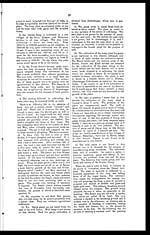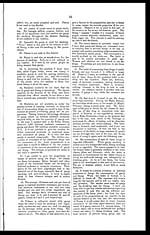Medicine - Drugs > Report of the Indian Hemp Drugs Commission, 1894-1895 > Volume VII > Evidence of Bombay witnesses
(48) Page 30
Download files
Individual page:
Thumbnail gallery: Grid view | List view

30
so trodden on becomes flat, when a second layer
of flowering tops and leaves is brought in and
pressed and trampled on; a third and fourth layer
is formed until the mass rises a foot high. The
treading is required in order to produce flat
sheaves of ganja, which is easily accomplished by
the resinous secretion which the plant and its
flowers contain. The exudation so produced
adheres to the crushed leaves and flowers and pro-
duces a mass. This process is repeated for three
or four consecutive days, by which time the pro-
duct gets dry. The small twigs are thrown away,
ganja is collected, the broken leaves and residue
of the ganja is also separately collected. Seed if
any is picked up and stored, ganja thus made is
then packed in bales, the broken leaves and the
small bits detached from ganja in the process of
manufacture are separately packed, and supply
what is known as bhang in this part of India.
This preparation should be regarded as "chur"
(broken ganja), but in this part of India it is sold
as bhang. The cutting is usually done by women
and the trampling by men. The women work
from 7 to 11 A.M., the men from 1 to 6 P.M., with
several intermissions.
Both ganja and "chur" are used for smoking.
The latter however rarely. "Chur" or "bhang"
is mostly used for drinking; ganja is also used
for preparing some of the narcotic preparations
usually used for eating. The methods followed
in preparing each of the preparations for smoking
and eating and drinking are as described below:—
1. Ganja for smoking.
The process of preparing this drug for smoking
is to take 2 or 3 flat tops and wash them with
water several times so as to remove any dirt,
stalks and seeds and other foreign matter. The
moisture is then pressed out, an equal quantity of
tobacco is added to the ganja thus washed, and
the whole mixture is put into a "chillum" or
"huka" bowl and is smoked.
2. Ganja for eating is used in four preparations,
viz.:—
(1) Majum, (2) yakuti, (3) shrikhand, (4)
gulkhand, which are made as under—
Take five sers of ganja and wash it three or four
times so as to remove dirt, seeds and stalks. Put
it into 20 sers of water with 2½ sers of ghi and
boil the mixture for 12 hours. Thus boiled with
ghi, the latter receives the narcotic properties of
the ganja. The mixture thus boiled is strained
through a thin clean cloth into a pan, The resi-
due is thrown away. When the ghi cools it is
collected in a separate receptacle and the water is
thrown away. This ghi is the principal consti-
tuent of each of the confections mentioned above.
(1) To prepare majum, make a syrup of one
ser of sugar, adding one-sixteenth of a ser of the
narcotised ghi prepared as above; mix well while
hot, pour the mixture into a broad-mouthed uten-
sil; when cool it hardens and is then cut into small
tablets. This is called " majum" and is eaten.
It is a favourite form of taking the drug. In
Upper India I learn it is made from bhang; but
in this part of the country I have ascertained it is
made mostly from ganja and very rarely from
bhang.
(2) To prepare "gulkhand." Take one ser of
the ordinary "gulkhand" (a confection of roses
and sugarcandy) and add to it one-sixteenth of a
ser of the narcotized ghi; mix them well together.
The preparation is called gulkhand, which is eaten.
(3) To prepare shrikhand. Take one ser of
jagri syrup, add one-sixteenth of the narcotized.
ghi and cardamons.
(4) To prepare yakuti. Take one ser of sugar
syrup and add one-sixteenth of the narcotized
ghi, flavour with cardamoms, nutmeg and mace,
and make up into lozenges. Yakuti is eaten.
No other preparations are made from ganja in
this part of the country.
Bhang.—I have already said that bhang as
such is not separately grown or produced in this
part of India. In Upper India the leaves of the
wild plant called "bhangara" yield bhang, the
cultivated female plant ganja. The description of
ganja as the "agglutinated female flowering
tops" may be accepted as true both here and
elsewhere, but the definition of bhang as the
"mature leaves of the wild plant," however
correct in Upper India, does not apply here, as the
wild plant is rare or is not known here. Bhang
as understood here does include leaves, but they
are the leaves of the female cultivated plant.
The term also includes what is called "chur" in
Upper India, which is made up of little bits of
flowers detached from ganja. Bhang is thus
taken to include the leaves and the bits that are
detached from the ganja plant while under the
process of treading on the threshing ground.
This bhang is used mostly for the purpose of
preparing a drink styled "gota," and is used by
the poorer classes for smoking.
For smoking, the process is the same as that for
ganja smoking. Gota is regarded as a delicious
beverage, and is prepared as under—
Take bhang and wash it three or four times.
Grind well on a stone slab until it is reduced to
fine powder. Add water little by little until a
green liquid is obtained. Then strain through a
cloth. Take one to two drachms of this liquid
and mix with milk and sugar, adding cardamoms,
pepper, aniseed, poppy seed, also almonds and
rose buds. This is held to be a very delicious and
refreshing beverage and is usually used in
summer.
16. Bhang is never prepared at home. It is
prepared in the field. Gota, which is a drink
made from bhang, is prepared at home. But
bhang is prepared almost always at the place
where the plant is grown in the field.
17. The preparation of hemp drugs is not confined
to any special classes. The ordinary agriculturists
who cultivate the plant, manufacture ganja and
bhang, and the several preparations from these
drugs are made by the vendors, who have to take
out licenses from the Collector of the district to
manufacture and sell the drugs.
18. Ganja and bhang deteriorate by keeping.
They retain their properties for about a year, whe-
ther well kept or not. There is deterioration also
by exposure. It is said to be quite unfit for use
after two years. The causes of deterioration are
damp and moisture, exposure to heat generally.
If well packed and carefully prepared, ganja and
bhang retain their properties for two years. The
measures taken against deterioration consist of
careful keeping to prevent the drug from expo-
sure to heat and damp.
19. Ganja is used for smoking as well as for
making up narcotic preparations, such as those
mentioned in my reply to question 15. For
smoking, ganja is used throughout the district
and for eatable narcotic confections in Poona city
and cantonments only. In the country, majum,
Set display mode to: Large image | Zoom image | Transcription
Images and transcriptions on this page, including medium image downloads, may be used under the Creative Commons Attribution 4.0 International Licence unless otherwise stated. ![]()
| India Papers > Medicine - Drugs > Report of the Indian Hemp Drugs Commission, 1894-1895 > Volume VII > Evidence of Bombay witnesses > (48) Page 30 |
|---|
| Permanent URL | https://digital.nls.uk/74910636 |
|---|




